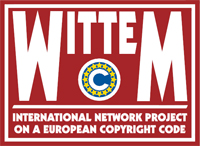 The European Copyright Code is the result of the Wittem Project that was established in 2002 as a collaboration between copyright scholars across the European Union concerned with the future development of European copyright law. The project has its roots in an International Network Program run by three Dutch universities (Radboud University of Nijmegen, University of Amsterdam and Leiden University), and sponsored by the government-funded Dutch ITeR Program.
The European Copyright Code is the result of the Wittem Project that was established in 2002 as a collaboration between copyright scholars across the European Union concerned with the future development of European copyright law. The project has its roots in an International Network Program run by three Dutch universities (Radboud University of Nijmegen, University of Amsterdam and Leiden University), and sponsored by the government-funded Dutch ITeR Program.
The aim of the Wittem Project and this Code is to promote transparency and consistency in European copyright law. The members of the Wittem Group share a concern that the process of copyright law making at the European level lacks transparency and that the voice of academia all too often remains unheard. The Group believes that a European Copyright Code drafted by legal scholars might serve as a model or reference tool for future harmonization or unification of copyright at the European level. Nevertheless, the Group does not take a position on the desirability as such of introducing a unified European legal framework.
The Code was drafted by a Drafting Committee composed of seven members. Each chapter of the Code was originally drafted by one or two members of the Drafting Committee, acting as rapporteurs. The rapporteurs for each chapter were: Prof. Quaedvlieg (Chapter 1: Works), Prof. Hugenholtz (Chapter 2: Authorship and ownership), Prof. Strowel (Chapter 3: Moral rights), Prof. Visser (Chapter 4: Economic rights) and Professors Dreier and Hilty (Chapter 5: Limitations).
Each draft Chapter, accompanied by an explanatory memorandum, was discussed in a plenary session with the members of the Wittem Advisory Board and other experts that were invited ad hoc. The proceedings of these plenary sessions were fed into the second versions of each chapter, and thereafter redacted and integrated into a final consolidated version by the Drafting Committee. Although discussions with the Advisory Board and experts have greatly influenced the final product, responsibility for the Code lies solely with the Drafting Committee.
While drafted in the form of a legislative instrument and thereby exceeding the level of detail normally associated with common principles of law, this Code is not comprehensive. It concentrates on the main elements of any codification of copyright: subject matter of copyright (Chapter 1), authorship and ownership (Chapter 2), moral rights (Chapter 3), economic rights (Chapter 4) and limitations (Chapter 5). The Code does not, for instance, treat such remuneration rights as public lending right and droit de suite, nor does it deal with the legal protection of technical measures. Also, the Code does not contain rules on copyright liability or enforcement, nor does it touch upon neighbouring (related) rights and database right.
This Code is not a recodification of EU copyright law tabula rasa. Since European copyright law must operate within the confines of the international commitments of the European Union and its Member States, the Code takes account of the substantive norms of the Berne Convention and the TRIPs Agreement. Also, the members of the Group have found it hard to ignore the acquis communautaire in the form of seven Directives that the European legislature has produced in this field since 1991. However, the Code does on occasion deviate from the acquis, and therefore cannot be considered a mere restatement or consolidation of the norms of the directives.
The members of the Wittem Group hope that this European Copyright Code will contribute to the establishment of a body of transparent and consistent copyright law that protects the moral and economic interests of creators, while serving the public interest by promoting the production and dissemination of works in the field of literature, art and science.
The European Copyright Code is available here.
26 April 2010